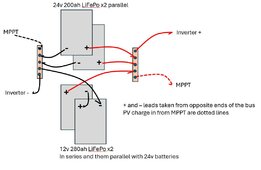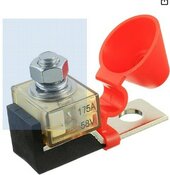RockOn
New Member
Have a bank which is now 2x 24v in parallel feeding 24v 3000 watt inverter.
Have 2x 12v 280ah batteries I want to add.
I know I may not be taking advantage of the full 280 ah but its what I have - same brand, BMS size, etc
So 2x 12v in series (hence 24v 280ah battery) in parallel with the existing 2x 24v batteries.
Its marine application so not used continuously and only used on the hook/mooring for 4-5 day trips.
At dock, PV and inverter are off and batteries are floated with a shore power charger.
And do not really have room for + / - bus bars so did this as "best" way to just wire from terminals.
Plan to use best practice of having inverter leads at opposite ends of the bank (see sketch)
Does this also hold true for where the PV lines MPPT lines should be attached for balancing? I'm assuming so. Opposite ends of the bank and opposite the inverter?
Or can it also be the same as the inverter - which is better? Does it matter?
Thanks for the feedback.
Have 2x 12v 280ah batteries I want to add.
I know I may not be taking advantage of the full 280 ah but its what I have - same brand, BMS size, etc
So 2x 12v in series (hence 24v 280ah battery) in parallel with the existing 2x 24v batteries.
Its marine application so not used continuously and only used on the hook/mooring for 4-5 day trips.
At dock, PV and inverter are off and batteries are floated with a shore power charger.
And do not really have room for + / - bus bars so did this as "best" way to just wire from terminals.
Plan to use best practice of having inverter leads at opposite ends of the bank (see sketch)
Does this also hold true for where the PV lines MPPT lines should be attached for balancing? I'm assuming so. Opposite ends of the bank and opposite the inverter?
Or can it also be the same as the inverter - which is better? Does it matter?
Thanks for the feedback.





